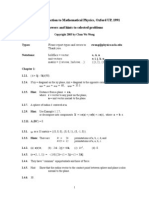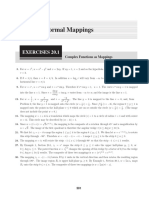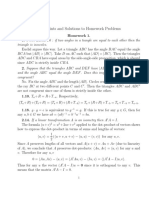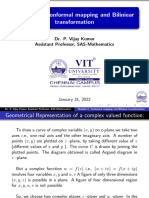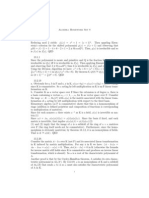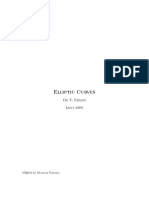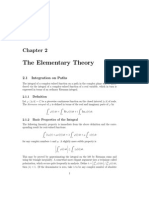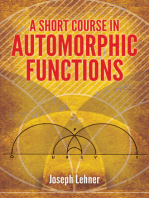Conformal Mappings
Conformal Mappings
Uploaded by
jeff_hammonds351Copyright:
Available Formats
Conformal Mappings
Conformal Mappings
Uploaded by
jeff_hammonds351Original Description:
Copyright
Available Formats
Share this document
Did you find this document useful?
Is this content inappropriate?
Copyright:
Available Formats
Conformal Mappings
Conformal Mappings
Uploaded by
jeff_hammonds351Copyright:
Available Formats
Conformal Mappings
Mustafa Akman
January 21, 2010
1
Contents
1 Introduction 1
2 Basic Properties of Conformal Mappings 2
3 Bilinear Transformations 5
3.1 The Implicit Formula . . . . . . . . . . . . . . . . . . . . . . . 6
4 Mappings Involving Elementary Functions 12
5 Mapping by Trigonometric Functions 15
6 Conclusion 19
1 Introduction
In mathematics, a conformal map is a function which preserves angels. In the
most common case the function is between domains in the complex plane.
More formally, a map f : U V is called conformal (or angel preserving)
at u
0
if it preserves oriented angles between curves through u
0
with respect
to their orientation. In 1569, the Flemish cartographer Gerardus Merca-
tor devised a cylindrical map projection that preserves angles. The Mercator
projection is still used today for world maps. Another map projection known
to the ancient Greeks is the stereographic projection and both examples are
conformal. In Complex analysis a function preserves angles if and only if
it is analytic or anti analytic. A signicant result, known as the Riemann
mapping theorem, states that any simply connected domain can be mapped
conformally onto the disk. Conformal mappings is very important in Com-
plex Analysis, as well as in many areas of physics and engineering. In this
project, I study about the some denitions and information about conformal
mapping and i am going to explain with some examples.
1
2 Basic Properties of Conformal Mappings
Denition 2.1. The mapping f(z) = f(x +iy) = u(x, y) +iv(x, y) is called
conformal if
It is one to one. (Bijection)
It and its inverse continuously dierentiable.
Image of every smooth curve of G
1
is a smooth curve of G
2
.
Angle between any two curves equals angle between their images.
Theorem 2.1. Let f : A B be analytic and let f
(z
o
) = 0 for each z
0
A. Then f is conformal.
Proof. We let C
1
and C
2
be two smooth curves passing through z
0
with
tangents given by T
1
and T
2
, respectively. We let
1
and
2
denote the
angles of inclination of T
1
and T
2
, respectively. The image curves K
1
and K
2
that pass through the point w
0
= f(z
0
) have tangents denoted T
1
and T
2
,
respectively.
Then the angles of inclination
1
and
2
of T
1
and T
2
are related to
1
and
2
by equations
1
= +
1
and
2
= +
2
, where = Arg f
(z
0
). Hence
2
1
=
2
1
. That is, the angle
2
1
from K
1
to K
2
is the same in
magnitude and orientation as the angle
2
1
from C
1
to C
2
. Therefore,
the mapping w = f(z) is conformal at z
0
.
2
Example 2.1. Show that the mapping w = f(z) = cos z is conformal at the
points z
1
= i, z
2
= 1, and z
3
= + i, and determine the angle of rotation
given by = Arg f
(z) at the given points.
Solution. Because f
(z) = sin z, we conclude that the mapping w = cos z
is conformal at all points except z = n, where n is an integer. Calculation
reveals that f
(i) = sin(i) = i sinh 1, f
(1) = sin 1 sinh 1, and
f
( +i) = sin( +i) = i sinh 1. Therefore, the angle of rotations are given
by
1
= Arg f
(i) =
2
,
2
= Arg f
(1) = ,
3
= Arg f
( + 1) =
2
.
Proposition 2.1. Let f : A B and g : B C be two conformal maps.
Then f
1
and g f are conformal, too.
Proof. Since f is bijective, the mapping f
1
exists. Then, f
1
is analytic
with df
1
(w)/dw = 1/[df(z)/dz] where w = f(z). Thus df
1
(w)/dw = 0, so
f
1
is conformal.
Certainly gf is bijective and analytic, since f and g are. Then derivative
of g f at z is g
(f(z))f
(z) = 0. Therefore g f is conformal.
Theorem 2.2 (Riemann Mapping Theorem). Let A be a connected and sim-
ply connected region other than the whole complex plane. Then there exists
a bijective conformal map f : A D where D = {z such that |z| < 1}.
Furthermore, for any xed z
0
A, we can nd and f such that f(z
0
) = 0
and f
(z
0
) > 0. With such a specication, f is unique.
Proof. (In this proof, we only show the uniqueness part) Suppose f and g
are bijective conformal maps of A onto D with f(z
0
) = g(z
0
) = 0, f
(z
0
) > 0,
and g
(z
0
) > 0. We want to show that f(z) = g(z) for all z in A. To do
this, dene h on D by h(w) = g(f
1
(w)) for w D. Then h : D D and
h(0) = g(f
1
(0)) = g(z
0
) = 0. By the Schwarz Lemma, |h(w)| |w| for all
w D. Exactly the same argument to h
1
= f g
1
, so that |h
1
()| ||
for all D. With = h(w), this gives |w| |h(w)|. Combining these
3
inequalities, we get |h(w)| = |w| for all w D. The Schwarz Lemma now
tells us that h(w) = cw for a constant c with |c| = 1. Thus cw = g(f
1
(w)).
With z = f
1
(w) we obtain cf(z) = g(z) for all z A. In particular,
cf
(z
0
) = g
(z
0
). Since both f
(z
0
) and g
(z
0
) are positive real numbers, so is
c. Thus, c = 1 and so f(z) = g(z), as desired.
Example 2.2. Show that the mapping w = f(z) = z
2
maps the unit square
S = {x + iy : 0 < x < 1, 0 < y < 1} onto the region in the upper half-plane
Im(w) > 0, which lies under the parabolas u = 1
1
4
v
2
and u = 1 +
1
4
v
2
.
Solution. z
2
= (re
i
)
2
= r
2
e
2i
doubles the angles and squares the norm.
Let
1
: z = x + iy, 0 x 1, y = 0,
2
: z = x + iy, x = 1, 0 y 1,
3
: z = x + iy, 0 x 1, y = 1 and
4
: z = x + iy, x = 0, 0 y 1.
Thus, it is easy to nd the images of
1
and
4
. If z
2
, then z = 1 + iy,
0 y 1 and u +iv = z
2
= 1 y
2
+ 2iy. Then,
u = 1 y
2
= 1
2y
2
2
= 1
v
2
2
= 1
v
2
4
, 0 v 2
. If z
2
, then z = x +i, 0 x 1 and u +iv = z
2
= x
2
1 + 2ix. Then,
u = x
2
1 =
2x
2
2
1 =
v
2
1 =
v
2
4
1 = 1 +
v
2
4
, 0 v 1
Note that, the angles at 1 and -1 are preserved but the angle at 0 is doubled.
4
Theorem 2.3. Let A be a bounded region with f : A C a bijective confor-
mal map onto its image f(A). Suppose that f extends to be continuous on
A and that f maps the boundary of A onto a circle of radius R. Then f(A)
equals the inside of that circle. More generally, if B is a bounded region that,
together with its boundary, can be mapped conformally onto the unit disk and
its boundary and if f maps (A) onto (B), then f(A) = B.
Proof. By composing f with the conformal map h that takes B to the unit
disk it is sucient to consider the special case in which B equals D = {z :
|z| < 1}. On (A), |f(z)| = 1, so by the Maximum Modulus Theorem,
|f(z)| 1 on A. Since f cannot be constant at no z A is the maximum
|f(z)| = 1 reached. We assumed that f((A)) = (D), but this is also
equal to (f(A)). To see this, use compactness of
A, continuity of f, and
D(D) = f(A) (f(A)) = . Thus our earlier argument applies to show
that f(A) = D.
3 Bilinear Transformations
A bilinear transformation is a mapping of the form
T(z) =
az +b
cz +d
where a, b, c, d are xed complex numbers and ad bc = 0 because otherwise
T would be a constant. T id also called a mobius transformation, or fractional
linear transformation.
Proposition 3.1. The map T dened in the preceding display is bijective
and conformal from the set
A = {z C : z =
d
c
} onto B = {w|w =
a
c
}
The inverse of T is also a fractional linear transformation given by
T
1
(w) =
dw +b
cw a
5
Proof. Certainly T is analytic on A and S(w) = (dw + b)/(cw a) is
analytic on B. The map T will be bijective if we can show that T S and
S T are the identities since this means that T has S as its inverse. Indeed,
this is seen in this computation.
T(S(w)) =
a(
dw+b
cwa
) +b
c(
dw+b
cwa
) +d
=
adw +ab +bcw ab
cdw +bc +dcw da
=
(bc ad)w
bc ad
= w
We can cancel because cwa = 0 and bcad = 0. Similarly, S(T(z)) = z.
Finally, T
(z) = 0 because
1 =
d
dz
[z] =
d
dz
[S(T(z))] = S
(T(z)).T
(z),
so T
(z) = 0.
3.1 The Implicit Formula
Theorem 3.1 (The Implicit Formula). There exist a unique bilinear trans-
formation that maps three distinct points, z
1
, z
2
and z
3
, onto three distinct
points, w
1
, w
2
and w
3
, respectively. An implicit formula for the mapping is
given by
z z
1
z z
3
z
2
z
3
z
2
z
1
=
w w
1
w w
3
w
2
w
3
w
2
w
1
Proof. Now we will solve w in terms of z. The result is an expression for w
that has the form of the rst formula of bilinear transformation, where the
coecients a, b, c and d involve various combination of the values z
1
, z
2
, z
3
,
w
1
, w
2
and w
3
. If we set z = z
1
and w = w
1
in the theorem, then both sides
of the equation are zero, showing w
1
is the image of z
1
. If we set z = z
2
6
and w = w
2
in theorem, then both sides of the equation take on the value 1.
Hence w
2
is the image of z
2
. Taking reciprocals we write the theorem in the
form of,
z z
3
z z
1
z
2
z
1
z
2
z
3
=
w w
3
w w
1
w
2
w
1
w
2
w
3
If we set z = z
3
and w = w
3
in the equation above, then both sides of the
equation are zero. Therefore w
3
is the image of z
3
, and we have shown that
the transformation has the required properties.
Corollary 3.1. (The implicit formula with a point at innity) In Implicit
Theorem, the point at innity can be introduced as one of the prescribed points
in either the z plane or the w plane.
Proof.
Case 1 If z
3
= , then we can write
z
2
z
3
z z
3
=
z
2
z
= 1 and substitute
this expression in to implicit theorem to obtain
z z
1
z
2
z
1
=
w
1
w w
3
w
2
w
3
w
2
w
1
Case 2 If w
3
= , then we can write
w
2
w
3
w w
3
=
w
2
w
= 1 and substitute
this expression in to implicit theorem to obtain
z
1
z z
3
z
2
z
3
z
2
z
1
=
w w
1
w
2
w
1
Example 3.1. a) Find the image of the unit circle |z| = 1 by the following
transformation w = u
z v
vz 1
, u, v are complex numbers and |z| = 1
b) Which bilinear transformation maps the unit circle |z| = 1 on the unit
circle |w| = 1? What is the image of the unit disc |z| 1 by this transfor-
mation?
Solution. a) Since
w w = u u
z z vz v z +v v
v vz z vz v z + 1
7
for z z = 1 we have that w w = u u. Therefore the unit circle |z| = 1 is mapped
on the circle |w| = |u|.
b) Using a) we obtain that the bilinear transformation
w = u
z v
vz 1
v = 1,
The unit disc |z| 1, for |v| < 1, is mapped on the unit disc |w| 1, and
for |v| > 1 on the region |w| 1.
Example 3.2. Show that w = s(z) =
i(1 z)
1 +z
maps the unit disk D : |z| < 1
one to one and onto the upper half-plane Im(w) > 0.
Solution. We rst consider the unit circle C : |z| = 1, which forms the
boundary of the disk and nd its image in the w plane. If we write S(z) =
iz +i
z + 1
, then wee see that a = i, b = i, c = 1 and d = 1. Using the inverse
transformation equation we nd that the inverse is given by
z = s
1
(w) =
dw +b
cw a
=
(1)w +i
(1)w (i)
=
w +i
w +i
If |z| = 1, then the equation on above implies that the images of points on
the unit circle satisfy |
w +i
w +i
| = 1 which yields the equation
|w +i| = | w +i|
Squaring both sides, we obtain u
2
+ (1 + v)
2
= u
2
+ (1 v)
2
, which can be
simplied to yield v = 0, which is the equation of the u-axis in the w plane.
The circle C divides the z plane in to two portions, and its image is the u
axis, which divides the w plane into two portions. The image of the point
z = 0 is w = S(0) = i, so we expect that the interior of the circle C is
mapped onto the portion of the w plane that lies above the u axis. To show
that this outcome is true, we let |z| < 1. Then the equation of inverse S is
implies that the image values must satisfy the inequality | w+i| < |w+i|,
8
which we write as d
1
= |w i| < |w (i)| = d
2
.
If we interpret d
1
as the distance from w to i and d
2
as the distance from
w to i, then a geometric argument shows that the image point w must lie
in the upper half-plane Im(w) > 0. As S(z) is one to one and onto in the
extended complex plane, it follows that S(z) maps the disk onto the half
plane.
Example 3.3. Find the bilinear transformation w = S(z) that maps the
points z
1
= 2, z
2
= 1, z
3
= 0 onto the points w
1
= 1, w
2
= 0, w
3
= 1,
respectively.
Solution. We use the implicit formula, and write
(z (2))((1 i) 0)
(z 0)((1 i) (2))
=
(w (1))(0 1)
(w 1)(0 (1))
(z + 2(1 i)
(z)(1 i + 2)
=
(w + 1)(1)
(w 1)(1)
z + 2
z
1 i
1 i
=
1 +w
1 w
Using the fact that
1 i
1 i
=
1
i
, we rewrite this equation as
z + 2
iz
=
1 +w
1 w
.
We now expand the equation and obtain (1-i)z+2=w((1+i)z+2) which can
be solved for w in terms of z, giving the desired solution
9
w = S(z) =
(1 i)z + 2
(1 +i)z + 2
Example 3.4. Show that the mapping
w = S(z) =
(1 i)z + 2
(1 +i)z + 2
maps the disk D : |z + 1| < 1 onto the upper half plane Im(w) > 0
Solution. For simplicity, we choose the ordered triple z
1
= 2, z
2
= 1 i,
z
3
= 0, which gives the circle C : |z + 1| = 1 a positive orientation and the
disk D a left orientation. From previous example image points are
w
1
= S(z
1
) = S(2) = 1
w
2
= S(z
2
) = S(1 i) = 0
w
3
= S(z
3
) = S(0) = 1
Because the ordered triple of points w
1
= 1, w
2
= 0, w
3
= 1, lie on
the u axis, it follows that the image of circle C is the u axis. The points
w
1
= 1, w
2
= 0, w
3
= 1 give the upper half plane G : Im(w) > 0 a left
orientation. Therefore w = S(z) =
(1 i)z + 2
(1 +i)z + 2
maps the disk D onto the
upper half plane G. To check our work, we choose a point z
0
that lies in D
and nd the half plane in which its image, w
0
lies. The choice z
0
= 1 yields
w
0
= S(z
0
) = i. Hence the upper half plane is correct image.
Example 3.5. Find the bilinear transformation that maps the crescent-
shaped region that lies inside the disk |z 2| < 2 and outside the circle
|z 1| = 1 onto a horizontal strip.
Solution. For simplicity, we choose z
1
= 4, z
2
= 2 + 2i and z
3
= 0 and the
image values w
1
= 0, w
2
= 1 and w
3
= , respectively. The ordered triple
10
z
1
, z
2
and z
3
gives the circle |z 2| = 2 a positive orientation and the disk
|z 2| < 2 has a left orientation. The image points w
1
, w
2
and w
3
all lie on
the extended u axis, and they determine a left orientation for the upper half
plane Im(w) > 0. Therefore, we can use the case 2 from corollary to write
z 4
z 0
2 + 2i 0
2 + 2i 4
=
w 0
1 0
which determines a mapping of the disk |z 2| < 2 onto the upper half
plane Im(w) > 0. We simplify the preceding equation to obtain the desired
solution
w = S(z) =
iz + 4i
z
A straightforward calculation shows that the points z
4
= 1 i, z
5
= 2, and
z
6
= 1 +i are mapped onto the points
w
4
= S(1 i) = 2 +i
w
5
= S(2) = i
w
6
= S(1 +i) = 2 +i
The points w
4
, w
5
, w
6
lie on the horizontal line Im(w) = 1 in the upper half
plane. Therefore, the crescent shaped region is mapped onto the horizontal
strip 0 < Im(w) < 1.
11
4 Mappings Involving Elementary Functions
The function w = f(z) = exp z is a one to one mapping of the fundamental
period strip < y in the z plane onto the w plane with the point w = 0
deleted. Because f
(z) = 0, the mapping w =exp z is a conformal mapping
at each point z in the complex plane. The family of horizontal lines y = c
for < c and the segments x = a for < y from an orthogonal
grid in the fundamental period strip. Their images under the mapping w =
exp z are the rays > 0 and = c and the circles |w| = e
a
, respectively.
The images from an orthogonal curvilinear grid in the w plane, as shown in
the shape.
If < c < d , then the rectangle R = {x+iy : a < x < b, c < y < d}
is mapped one to one and onto the region G = {e
i
: e
a
< < e
b
, c < < d}.
The inverse mapping is the principal branch of the logarithm z = Log w.
12
Example 4.1. Show that the transformation
w = f(z) =
e
z
i
e
z
+i
is a one to one conformal mapping of the horizontal strip 0 < y < onto the
disk |w| < 1. Furthermore, the x axis is mapped onto the lower semicircle
bounding the disk, and the line y = is mapped onto the upper semicircle.
Solution. The function f is the composition of Z =exp z followed by w =
Z i
Z +i
. The transformation Z =exp z maps the horizontal strip 0 < y <
onto the upper half plane Im(Z) > 0, the x axis is mapped on to the positive
X axis and the line y = is mapped onto the negative X axis. Then the bi-
linear transformation w =
Z i
Z +i
maps the upper half plane Im(Z) > 0 onto
the disk |w| < 1, the positive X axis is mapped onto the lower semicircle,
and the negative X axis onto the upper semicircle. We can see composite
mapping in the shape.
Example 4.2. Show that the transformation w = f(z) = Log(
1 +z
1 z
) is a
one to one conformal mapping of the unit disk |z| < 1 onto the horizontal
13
strip |v| <
2
. Furthermore, the upper semicircle of the disk is mapped onto
the line v =
2
and the lower semicircle onto v =
2
.
Solution. The function w = f(z) is the composition of the bilinear trans-
formation Z =
1 +z
1 z
followed by the logarithmic mapping w = Log z. The
image of the disk |z| < 1 under the bilinear mapping Z =
1 +z
1 z
is the right
half plane Re(Z) > 0, the upper semicircle is mapped onto the positive Y axis.
The logarithmic function w = Log z then maps the right half plane onto the
horizontal strip, the image of the positive Y axis is the line v =
2
and the
image of the negative Y axis is the line v =
2
. We can see composite
mapping in the shape.
Example 4.3. Show that the transformation w = f(z) = (
1 +z
1 z
)
2
is a one to
one conformal mapping of the portion of the disk |z| < 1 that lies in the upper
half plane Im(z) > 0 onto the upper half plane Im(w) > 0. Furthermore,
show that the image of the semicircular portion of the boundary is mapped
onto the negative uaxis, and the segment 1 < x < 1, y = 0 is mapped onto
the positive uaxis.
14
Solution. The function w = f(z) is the composition of the bilinear trans-
formation Z =
1 +z
1 z
followed by the mapping w = Z
2
. The image of the
half disk under the bilinear mapping Z =
1 +z
1 z
is the rst quadrant X > 0,
Y > 0, the image of the segment y = 0, 1 < x < 1, is the positive
Xaxis, and the image of the semicircle is the positive Y axis. The mapping
w = Z
2
then maps the rst quadrant in the Z plane onto the upper half
plane Im(w) > 0, as we can see in the gure.
Example 4.4. Consider the function w = f(z) = (z
2
1)
1
2
, which is the
composition of the functions Z = z
2
1 and w = Z
1
2
, where the branch of
the square root is Z
1
2
= R
1
2
(cos
2
+i sin
2
), where 0 < 2. Show that
the transformation w = f(z) maps the upper half plane Im(z) > 0 one to
one and onto the upper half plane Im(w) > 0 slit along the segment u = 0,
0 < v 1.
Solution. The function Z = z
2
1 maps the upper half plane Im(z) > 0
one to one and onto the Z plane slit along the ray Y = 0, X 1. Then
the function w = Z
1
2
maps the slit plane onto the slit half plane, as shown
in the gure.
5 Mapping by Trigonometric Functions
The trigonometric functions can be expressed with compositions that involve
the exponential function followed by a bilinear function. We can nd images
of certain regions by following the shapes of successive images in the com-
posite mapping.
Example 5.1. Show that the transformation w = tan z is a one to one
conformal mapping of the vertical strip |x| <
4
onto the unit disk |w| < 1.
15
Figure 1: Example 4.3
Figure 2: Example 4.4
Solution. Using equations sin z =
1
2i
(e
iz
e
iz
) and cosz =
1
2
(e
iz
+ e
iz
),
we write
w = tan z =
1
i
e
iz
e
iz
e
iz
+e
iz
=
ie
i2z
+i
e
i2z
+ 1
Then, mapping w = tan z can be considered to be the composition
w =
iZ +i
Z + 1
andZ = e
i2z
.
The function Z = exp (i2z) maps the vertical strip |x| <
4
one to one
and onto the right half plane Re(Z) > 0. Then the bilinear transformation
16
w =
iZ +i
Z + 1
maps the half plane one to one and onto the disk, as show in
the picture.
Example 5.2. Show that the transformation w = f(z) = sin z is a one to
one conformal mapping of the vertical strip |x| <
2
onto the w plane slit
along the rays u 1, v = 0, and u 1, v = 0.
Solution. Because f
(z) =cosz = 0 for values of z satisfying the inequality
2
< Re(z) <
2
, it follows that e = sin z is a conformal mapping.
u +iv = sin z = sin x cosh y +i cos x sinh y
If |a| <
2
, then the image of the vertical line x = a is the curve in the w
plane given by the parametric equations
u = sin a cosh y and v = cos a sinh y
for < y < . Next, we rewrite these equations as
cosh y =
u
sin a
and sinh y =
v
cos a
17
We now eliminate y from these equations by squaring and using the hyper-
bolic identity cosh
2
y sinh
2
y = 1. The result is the single equation
u
2
sin
2
a
v
2
cos
2
a
= 1
The curve given by
u
2
sin
2
a
v
2
cos
2
a
= 1 is identied as a hyperbola in the uw
plane that has foci at the points (1, 0). Therefore, the vertical line x = a
is mapped one to one onto the branch of the hyperbola
u
2
sin
2
a
v
2
cos
2
a
= 1
that passes through the points (sin a, 0). If 0 < a <
2
, then it is the right
branch, if
2
< a < 0, it is the left branch. The image of the y axis, which
is the line x = 0, is the v axis. The images of several vertical lines are shown
in the rst part of shape.
The image of the horizontal segment
2
< x <
2
, y = b is the curve in the
w plane given by the parametric equations
u = sin x cosh b and v = cos x sinh b
for
2
< x <
2
. We rewrite them as
sin x =
u
cosh b
and cos x =
v
sinh b
We now eliminate x from the equations by squaring and using the trigono-
metric identity sin
2
x + cos
2
x = 1. The result is the single equation
u
2
cosh
2
b
+
v
2
sinh
2
b
= 1
The curve given by
u
2
cosh
2
b
+
v
2
sinh
2
b
= 1 is identied as an ellipse in the
uw plane that passes through the points (cosh b, 0) and (0, sinh b) and
has foci at the points (1, 0). Therefore, if b > 0, then v = cos x sinh b > 0,
and the image of the horizontal segment is the portion of the ellpse given by
u
2
cosh
2
b
+
v
2
sinh
2
b
= 1 that lies in the upper half plane im(w) > 0. If b < 0,
then it is the portion that lies in the lower half plane. The images of several
segments are show in the second part of the gure.
18
6 Conclusion
In this project, we have studied the bilinear transformations, mappings in-
volving elementary functions, mapping by trigonometric functions. Before
giving details of bilinear transformation, weve shown basic properties and
dened conformal mapping theorem and riemann mapping theorem. Then,
we have given the deniton of implicit formula. Then we have shown map-
pings involving elemantary functions and mappings of trigonometric func-
tions with some examples. Moreover, we have shown on gures how functions
are mapped.
19
References
[1] Complex Analysis for Mathematics and Engineering, John H.Mathews,
Russel W.Howell, Jones and Bartlett, 2006
[2] Basic Complex Analysis, Jerrold E. Marsden, Michael J. Homan, W.
H. Freeman, 1999
[3] Theory and Problems of Complex Variables, Murray R.Spiegel,
McGraww-Hill, 1981
[4] Complex Analysis through Examples and Exercises, Endre Pap, Kluwer
Academic Publisher, 1999
[5] Complex Analysis, Theodore W.Gomelin, Springer, 2001
[6] math.fullerton.edu/mathews/c2003/ComplexUndergradMod.html
20
You might also like
- Problemas de Teoría Del Buque Cesareo Díaz Fernández100% (1)Problemas de Teoría Del Buque Cesareo Díaz Fernández312 pages
- Partial Solutions Manual For Chun Wa Wong Introduction To Mathematical Physics0% (2)Partial Solutions Manual For Chun Wa Wong Introduction To Mathematical Physics9 pages
- The Geometry of Möbius Transformations: John OlsenNo ratings yetThe Geometry of Möbius Transformations: John Olsen37 pages
- Solutions To Exercises 6.1: Conformal MappingsNo ratings yetSolutions To Exercises 6.1: Conformal Mappings17 pages
- Math 225B: Differential Geometry, Homework 6: Ian Coley February 13, 2014No ratings yetMath 225B: Differential Geometry, Homework 6: Ian Coley February 13, 20146 pages
- Mathematics 113, Problem Set 3 Solutions: Alexander P. EllisNo ratings yetMathematics 113, Problem Set 3 Solutions: Alexander P. Ellis3 pages
- Module 2: Conformal Mapping: Dr. T. PhaneendraNo ratings yetModule 2: Conformal Mapping: Dr. T. Phaneendra13 pages
- Mock Olympiad Solutions - 2014 Winter CampNo ratings yetMock Olympiad Solutions - 2014 Winter Camp4 pages
- Module 2: Conformal Mapping: Dr. T. Phaneendra January 3, 2019No ratings yetModule 2: Conformal Mapping: Dr. T. Phaneendra January 3, 201913 pages
- Lecture Note Conformal Mapping MAT-303 (Unit 3)No ratings yetLecture Note Conformal Mapping MAT-303 (Unit 3)25 pages
- Algebra Homework Set 8 Hung Tran. 9.4.2.c Reducing Mod 2No ratings yetAlgebra Homework Set 8 Hung Tran. 9.4.2.c Reducing Mod 23 pages
- Cal145 Directional Derivatives and Gradients of Functions of Three VariablesNo ratings yetCal145 Directional Derivatives and Gradients of Functions of Three Variables4 pages
- Course Materials for MAC331_Conformal Mapping_Bilinear Transformation-1No ratings yetCourse Materials for MAC331_Conformal Mapping_Bilinear Transformation-15 pages
- Homework 27 Solution: Math 21a Spring, 2014No ratings yetHomework 27 Solution: Math 21a Spring, 20144 pages
- 5 Applications of Cauchy's Integral Theorem(s) : For Continuous Functions F: D C We DefineNo ratings yet5 Applications of Cauchy's Integral Theorem(s) : For Continuous Functions F: D C We Define11 pages
- Linear Algebra II Homework 7 Diego Gomez: S S S S S S S S S S S S S S S S S SNo ratings yetLinear Algebra II Homework 7 Diego Gomez: S S S S S S S S S S S S S S S S S S4 pages
- Rutgers University Graduate Program in MathematicsNo ratings yetRutgers University Graduate Program in Mathematics13 pages
- Mean Value Theorem and Analytic FunctionsNo ratings yetMean Value Theorem and Analytic Functions7 pages
- MIT Multivariable Calculus Exam A SolutionsNo ratings yetMIT Multivariable Calculus Exam A Solutions16 pages
- The Elementary Theory: 2.1 Integration On PathsNo ratings yetThe Elementary Theory: 2.1 Integration On Paths28 pages
- Errata Sheet For Chun Wa Wong Introduction To Mathematical PhysicsNo ratings yetErrata Sheet For Chun Wa Wong Introduction To Mathematical Physics2 pages
- Laurent Series Examples: Homework 3 Due Friday, November 15 at 5 PMNo ratings yetLaurent Series Examples: Homework 3 Due Friday, November 15 at 5 PM9 pages
- Higher Transcendental Functions Volume 1No ratings yetHigher Transcendental Functions Volume 1326 pages
- Discover The Stars - Gaylord Johnson e Irving AdlerNo ratings yetDiscover The Stars - Gaylord Johnson e Irving Adler154 pages
- Bab Iii Analisa Dan Perhitungan Alinyemen Horizontal: Max NNo ratings yetBab Iii Analisa Dan Perhitungan Alinyemen Horizontal: Max N41 pages
- Regional Planning: - Vaibhav B PadashettyNo ratings yetRegional Planning: - Vaibhav B Padashetty12 pages
- A Gis Application To Mineral Exploration in GhanaNo ratings yetA Gis Application To Mineral Exploration in Ghana2 pages
- Geography Project: Name-Class - Sec - Roll No.No ratings yetGeography Project: Name-Class - Sec - Roll No.28 pages
- Spanish Empire Aztecas Mayas Incas ShortNo ratings yetSpanish Empire Aztecas Mayas Incas Short35 pages
- NFPA Risk Assessment Worksheet - TLP-Tennessee Lightning ProtectionNo ratings yetNFPA Risk Assessment Worksheet - TLP-Tennessee Lightning Protection5 pages
- The Ecological Vulnerability Evaluation in Southwestern Mountain Region of China Based On GIS and AHP MethodNo ratings yetThe Ecological Vulnerability Evaluation in Southwestern Mountain Region of China Based On GIS and AHP Method11 pages
- Procedures of Investigation Flowchart (Flow Process of Project) (Investigation) (Objective of Investigation) (Main Items of Investigation)No ratings yetProcedures of Investigation Flowchart (Flow Process of Project) (Investigation) (Objective of Investigation) (Main Items of Investigation)1 page
- Problemas de Teoría Del Buque Cesareo Díaz FernándezProblemas de Teoría Del Buque Cesareo Díaz Fernández
- Partial Solutions Manual For Chun Wa Wong Introduction To Mathematical PhysicsPartial Solutions Manual For Chun Wa Wong Introduction To Mathematical Physics
- The Geometry of Möbius Transformations: John OlsenThe Geometry of Möbius Transformations: John Olsen
- Math 225B: Differential Geometry, Homework 6: Ian Coley February 13, 2014Math 225B: Differential Geometry, Homework 6: Ian Coley February 13, 2014
- Mathematics 113, Problem Set 3 Solutions: Alexander P. EllisMathematics 113, Problem Set 3 Solutions: Alexander P. Ellis
- Module 2: Conformal Mapping: Dr. T. Phaneendra January 3, 2019Module 2: Conformal Mapping: Dr. T. Phaneendra January 3, 2019
- Algebra Homework Set 8 Hung Tran. 9.4.2.c Reducing Mod 2Algebra Homework Set 8 Hung Tran. 9.4.2.c Reducing Mod 2
- Cal145 Directional Derivatives and Gradients of Functions of Three VariablesCal145 Directional Derivatives and Gradients of Functions of Three Variables
- Course Materials for MAC331_Conformal Mapping_Bilinear Transformation-1Course Materials for MAC331_Conformal Mapping_Bilinear Transformation-1
- 5 Applications of Cauchy's Integral Theorem(s) : For Continuous Functions F: D C We Define5 Applications of Cauchy's Integral Theorem(s) : For Continuous Functions F: D C We Define
- Linear Algebra II Homework 7 Diego Gomez: S S S S S S S S S S S S S S S S S SLinear Algebra II Homework 7 Diego Gomez: S S S S S S S S S S S S S S S S S S
- Rutgers University Graduate Program in MathematicsRutgers University Graduate Program in Mathematics
- Errata Sheet For Chun Wa Wong Introduction To Mathematical PhysicsErrata Sheet For Chun Wa Wong Introduction To Mathematical Physics
- Laurent Series Examples: Homework 3 Due Friday, November 15 at 5 PMLaurent Series Examples: Homework 3 Due Friday, November 15 at 5 PM
- Discover The Stars - Gaylord Johnson e Irving AdlerDiscover The Stars - Gaylord Johnson e Irving Adler
- Bab Iii Analisa Dan Perhitungan Alinyemen Horizontal: Max NBab Iii Analisa Dan Perhitungan Alinyemen Horizontal: Max N
- NFPA Risk Assessment Worksheet - TLP-Tennessee Lightning ProtectionNFPA Risk Assessment Worksheet - TLP-Tennessee Lightning Protection
- The Ecological Vulnerability Evaluation in Southwestern Mountain Region of China Based On GIS and AHP MethodThe Ecological Vulnerability Evaluation in Southwestern Mountain Region of China Based On GIS and AHP Method
- Procedures of Investigation Flowchart (Flow Process of Project) (Investigation) (Objective of Investigation) (Main Items of Investigation)Procedures of Investigation Flowchart (Flow Process of Project) (Investigation) (Objective of Investigation) (Main Items of Investigation)

